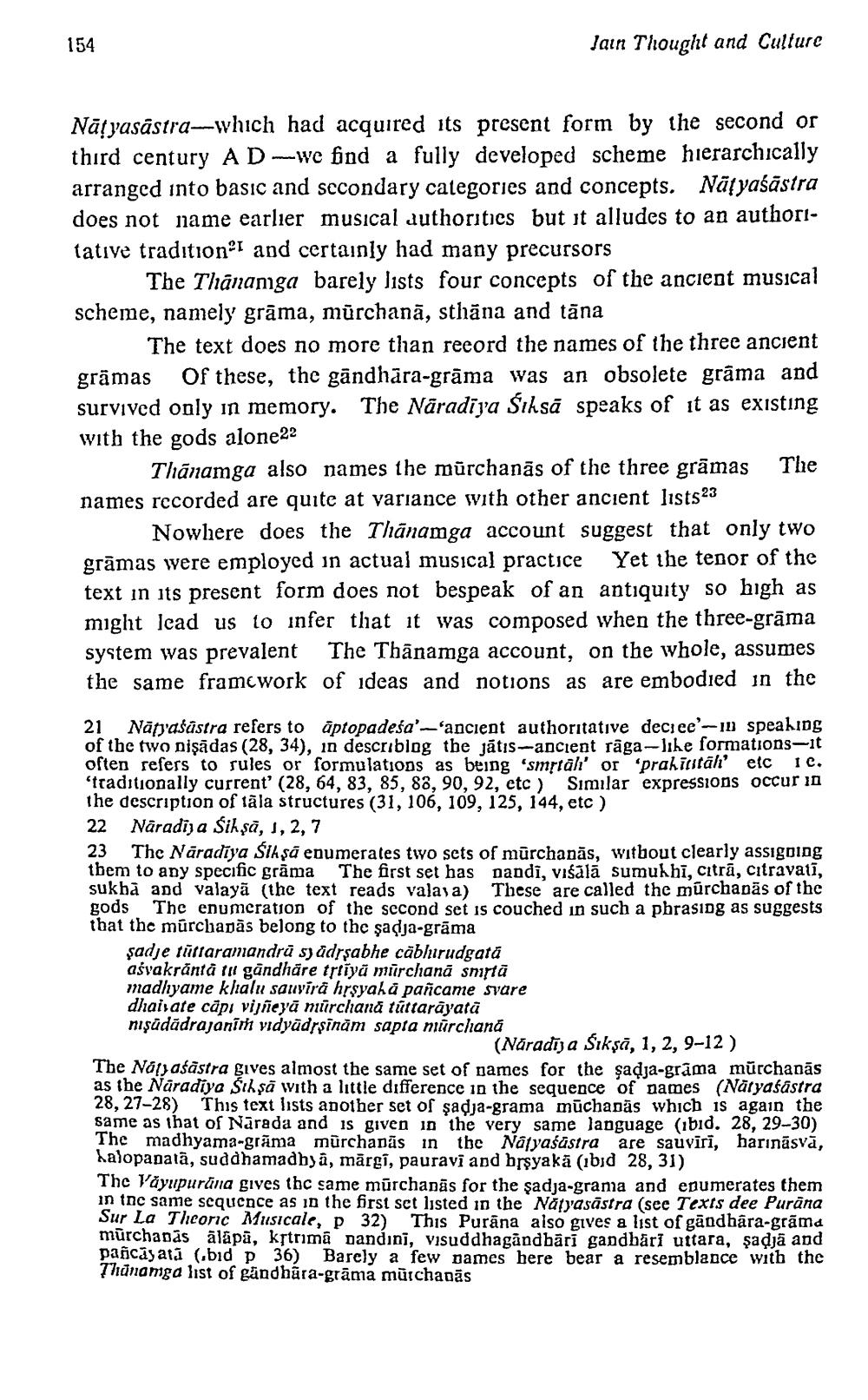________________
154
Jain Thought and Culture
Nāļyasastra—which had acquired its present form by the second or third century AD-We find a fully developed scheme hierarchically arranged into basic and secondary categories and concepts. Nät yaśāstra does not name earlier musical authorities but it alludes to an authoritative traditional and certainly had many precursors
The Thānanga barely lists four concepts of the ancient musical scheme, namely grāma, mūrchanā, sthāna and tāna
The text does no more than record the names of the three ancient grāmas Of these, the gāndhāra-grāma was an obsolete gráma and survived only in memory. The Náradiya Śıksā speaks of it as existing with the gods alone22
Thānamga also names the mūrchanās of the three grāmas The names recorded are quite at variance with other ancient lists23
Nowhere does the Thānamga account suggest that only two grāmas were employed in actual musical practice Yet the tenor of the text in its present form does not bespeak of an antiquity so high as might lead us to infer that it was composed when the three-grāma system was prevalent The Thānamga account, on the whole, assumes the same framework of ideas and notions as are embodied in the
21 Nātjaśāstra refers to aptopadeśa'--'ancient authoritative decice'-11 speaking of the two pişādas (28, 34), in describlog the jātis--ancient raga-lihe formations-it often refers to rules or formulations as being 'smrtal' or 'prahirital' etc 10. 'traditionally current (28, 64, 83, 85, 89, 90, 92, etc) Similar expressions occur in the description of tāla structures (31, 106, 109, 125, 144, etc ) 22 Nāradija Śikṣā, 1, 2, 7 23 Thc Náradiya Sih så enumerates two sets of mūrchanās, witbout clearly assigning them to any specific grāma The first set has nandi, visālā sumukhī, citrā, citravatī, sukbà add valayā (the text reads valaya) These are called the murchapäs of the gods The enumeration of the second set is couched in such a phrasing as suggests that the murchapās belong to the sadja-grāma
sadje tüftaramandru sjádrsabhe cäbhirudgata aśvakrăntă til gandháre trtīyā mrchanā smirtā madhyame khalu sauvira hrsyaha pañcame svare dhaisare căpi vijñeyā mūrchaná tűttarāyatā nışūdādrajanim vidyādrşinām sapra mūrchana
(Näradīja Śikṣā, 1, 2, 9-12) The Noyaśāstra gives almost the same set of names for the sadja-grāma mūrchanās as the Náradiya Sikşā with a little difference in the sequence of names (Naryaśāstra 28, 27-28) This text lists another set of sadja-grama mūchanās which is again the same as that of Nārada and is given in the very same language (ibid. 28, 29-30) The madhyama-grāma mūrchanās in thc Nafyaśāstra are sauvīri, harināsvā, halopapalā, suddhamadhyā, mārgi, pauravi and brsyakä (ibid 28, 31) The Vayupurāna gives the same mūrchadās for the sadja-grama and enumerates them in inc same sequence as in the first set listed in the Natyasāstra (see Texts dee Purana Sur La Theoric Musicale, p 32) This Purāna also gives a list of gāndhāra-grāmd mürchanás alapā, kstrimá Dandini, visuddhagandbāri gandhāri uttara, şadja and pafcāyatā (bid p 36) Barely a few dames here bear a resemblance with the Thanamga list of gāndhára-grāma mūrchanās




